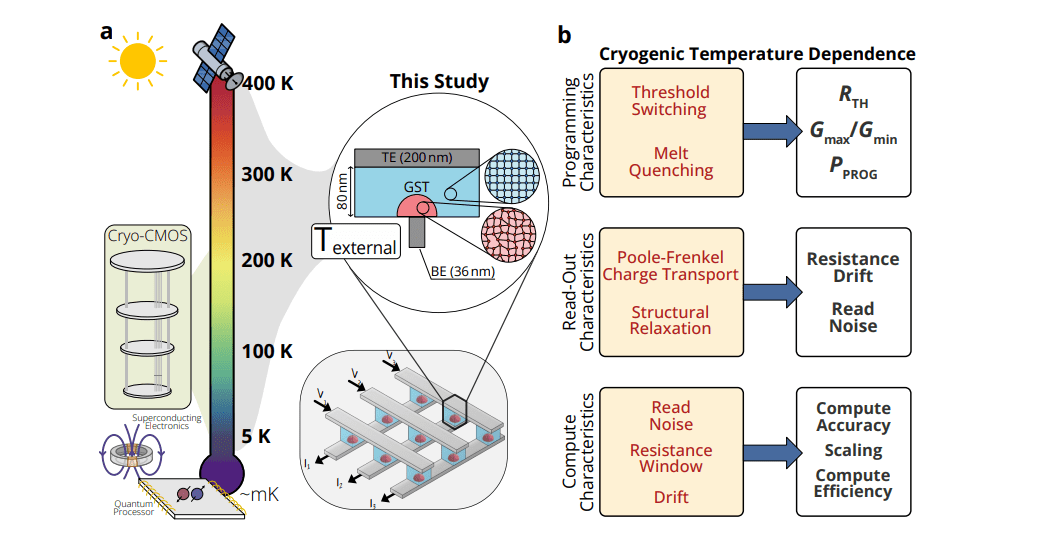In-memory computing represents a fundamentally new approach to processing data, moving computation directly into the memory itself and bypassing traditional computer architecture limitations. Davide G. F. Lombardo, Siddharth Gautam, and Alberto Ferraris, all from IBM Research, Europe and École polytechnique fédérale de Lausanne (EPFL), alongside Manuel Le Gallo, Abu Sebastian, and Ghazi Sarwat Syed from IBM Research, Europe, now present a detailed investigation into the potential of phase-change memory for this emerging field. Their work focuses on understanding how these memory devices behave at extremely low temperatures, down to just 5 Kelvin, a range crucial for applications like quantum computing and electronics designed for deep space exploration. By systematically characterising the physical processes within phase-change memory at cryogenic levels, the team reveals key insights into device programming, electrical transport, and noise characteristics, ultimately paving the way for more efficient and precise in-memory computation in challenging environments.
Among various candidates, phase-change memory (PCM) has emerged as a leading non-volatile technology, showing significant promise for in-memory computing (IMC), particularly in deep learning acceleration. PCM-based IMC is also poised to play a pivotal role in cryogenic applications, including quantum computing and deep space electronics. This work presents a comprehensive characterization of PCM devices across temperatures down to 5 K, covering the range most relevant to these domains. The team systematically investigates key physical mechanisms such as phase transitions and threshold switching that govern device programming at low temperatures, and examines attributes including electrical transport, retention, and endurance, providing critical insights for the development of robust and reliable cryogenic memory systems.
Temperature Dependence of Phase-Change Memory Performance
This research investigates the temperature-dependent behavior of phase-change memory (PCM) devices, specifically focusing on their suitability for in-memory computing applications across a wide temperature range (5K to 400K). The study examined programming characteristics, including how temperature affects the power required to switch the PCM between its amorphous and crystalline states, and read-out characteristics, focusing on how temperature influences the resistance of the PCM and the ability to reliably distinguish between states. Researchers also investigated compute characteristics, assessing how temperature affects the accuracy and reliability of performing matrix-vector multiplication using a PCM crossbar array, and characterized noise and drift to understand sources of resistance fluctuations. The team fabricated mushroom-type PCM devices using a chalcogenide material and characterized them using a cryostat to control temperature.
Electrical measurements included programming curves, resistance measurements, noise measurements, and drift measurements. Simulations modeled the performance of a PCM crossbar array for matrix-vector multiplication, considering device variability and drift. Results demonstrate that the power required to reset the device increases as temperature decreases, while the difference in resistance between the reset and set states, known as the memory window, is also affected by temperature. Threshold voltage, current, and power for resetting the device all decrease with decreasing temperature. The resistance of the reset state exhibits thermally activated behavior, with the slope of the Arrhenius plot indicating the activation energy. The rate of resistance change, known as the drift coefficient, is strongly temperature-dependent, exhibiting different regimes including structural relaxation, random fluctuation, and partial crystallization. Noise characteristics were analyzed using current power spectral density measurements, and simulations showed that the accuracy of matrix-vector multiplication is affected by device drift and temperature, with errors increasing with time and being more pronounced at higher temperatures.
Cryogenic Phase-Change Memory Performance Characterization
Scientists have comprehensively characterized phase-change memory (PCM) devices across a wide temperature range, extending down to 5 Kelvin, to assess their potential for cryogenic applications such as quantum computing and deep space electronics. Experiments revealed that the power required to trigger a state change in the PCM devices decreases as the temperature is lowered, demonstrating a more efficient programming process at cryogenic levels. Specifically, for the reset operation, both programming power and current increased with decreasing temperature, while the set operation showed an increase in threshold voltage coupled with a decrease in both threshold current and power. Investigations into electrical transport properties revealed a transition in conduction mechanisms at low temperatures.
The high-resistance states of the PCM devices followed Arrhenius-type behavior, with resistance exponentially increasing with decreasing temperature, characterized by an effective activation energy. Below 180 Kelvin, this behavior shifted, and below 150 Kelvin, the resistance scaling transitioned to a weaker temperature dependence, consistent with variable-range hopping conduction. Below 75 Kelvin, the resistance flattened, suggesting field-driven tunneling processes become dominant. In contrast, the set states exhibited a weak, nearly linear decrease in resistance with decreasing temperature. Devices with higher initial resistance values demonstrated slightly higher temperature coefficients of resistance, attributed to Anderson localization effects induced by vacancy disorder within the material.
PCM Performance at Cryogenic Temperatures
This research presents a comprehensive characterization of phase-change memory (PCM) devices at extremely low temperatures, down to 5 Kelvin, relevant to emerging applications like cryogenic computing and deep space electronics. Through detailed electrical measurements, the team demonstrates that the fundamental mechanisms governing PCM operation remain valid even at these ultra-low temperatures, though material properties shift measurably. Analysis of how devices read data reveals transitions in the dominant transport mechanisms as temperature decreases, moving from band conduction at higher temperatures to hopping and ultimately tunneling-dominated transport at the lowest temperatures. Furthermore, the study highlights the complex interplay of multiple device characteristics that determine computational accuracy in cryogenic environments, and acknowledges that resistance drift also changes with temperature, impacting long-term reliability. These findings provide fundamental insights into the behavior of PCM devices in a temperature regime of increasing importance, offering a basis for optimizing device design and operation for future cryogenic computing systems.

